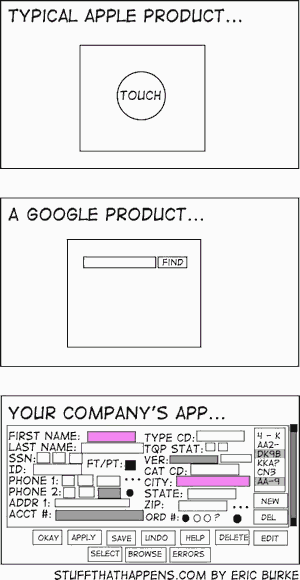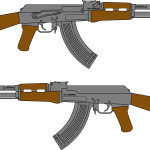“Complexity is your enemy. Any fool can make something complicated. It is hard to make something simple.“
Sir Richard Branson
Contents

So let’s Design Simple and here is why and how!
See the lithography above, from Pablo Picasso’s sketch of one of his famous bulls (from Les 11 états successifs de la lithographie Le Taureau, 1945)
While most of us would have been more than proud of the first version, it took him 11 versions to get to the simplest version, where any line counts & makes his bull unforgettable. Design Simple was part of the goal here.
In just a few lines, the bull is recognizable and has all its visual identities (shape of the back, tail, brave horns, male attributes) in order to pass a strong message while less-important details have disappeared completely.
This example is taken, from an excellent article taken from the book of the famous Fernand Mourlot lithograph printer “Gravés dans ma mémoire”, Ed. Robert Laffont (1979); buy the book or see the article directly here (in french).
View the Lego campaigns, and plain the simplicity creativity game, to help define what is the simplest design and parameters that still convey the design idea or provide the needed functions:
“Just because you can doesn’t mean you should” make it complex
Nowadays, plenty of unused features are less valued as marketing arguments than simplicity and ergonomics. That clearly has not been always the case.

Remember the washing machines in the 80s with 50+ washing programs? While you were just using “White” or “Color” and dry or not at the end. Now arguments are simplicity first, offset time start, energy consumption, and sometimes noise level.
Keep It Simple (Stupid) or Less is More
If the illustration on the right would not sufficient, there are many reasons one would Design Simple. Design Simple permits
- simple to design; which means in less time on the market
- simplicity to build, assemble & control; frequently means cheaper
- simpler for your users to learn and use
- means also reliable & easy to maintain with standards parts and not too many specific tools or training
How many times was your latest-hip-full-of-gadgets product out of service because of a secondary function that you don’t even use?
But gadgets make selling easier, at least in the first place.
Do we really need cars with:
-
- glasses opening some millimeters, just before closing the door to avoid the slight discomfort of overpressure? (just calculate the %time of usage in the product lifetime, potential inducted failures as the additional wearing of motor and sealings …)
-
- some lights on mirrors to indicate another car is passing nearby? (preventive security, agree is arguable)
Are these not the most likely to fail? (because of complexity, less development, and less validation compared to main functions …)
Note that the above automotive examples are really linked to car marketing strategy and that some very high brands do not have these at all but focus on the 2nd decimal of consumption -used all the %time- or more direct safety features.
Do as in the Toki Pona language: design everything using the same 120 tools and elements! That will force for simplicity and insure the Just Necessary of the product functions.
Toki Pona (literally good language, language of good) is a full language invented in 2001 by Sonja Lang, aiming for simplicity and good.
With only 120 words you can express everything, obliging you to go straight to the point in a positive manner.
Among these advantages, it is said you can learn bases of Esperanto in 1 month & Toki Pona in one day.
Ex.: “linja” will stand for “line”, “hair”, “wire”.
When More is just … too much!
Don’t add additional spares: remember these DIY assemble shelves, when you finished to assembled them, you are left with one or two additional screws or nuts? Were they provided as spares, or did you just forget them? Just don’t put them, or be very clear on their purpose in the assembly instructions. (as always, use with the brain; fragile rare bulbs or easy-to-loose tiny screws can be an exception)
Form Follows Functions
This concept was invented in architecture in the early 1900s by Louis Sullivan and later followed by Frank Lloyd Wright and other architects.

In more mechanical design, this concept would be related to ergonomics and usability.
Some famous aesthetical designers have followed that with great success in the last 20 years. One of the iconic examples is the lean Juice Squizeer designed by Philippe Stack and produced by Alessi using the casting technic on the right:
All is about Forms and Functions in Stark’s lean design:
-
- The form on the top to shred the pulp
-
- the form in the middle to direct the juice to one central point, above the glass
-
- the three legs (not hyperstatic) with angles to stay out of the juice
Not to mention the original shapes and ideas (rocket, ant, tree, nature …); some may argue about the volume taken in the kitchen for storage … simplicity & robustness do not have much to deal with folding and fragile sub-parts. Good products are likely more frequently used, stay in focus, and therefore not be stored.
See our detailed Forms Follows Function article and image library:
Jugaad to Design Simple
From the famous eponym book from Navi RADjou, Jaideep PRABHU, and Simone AHUJA.
This promotes not only simplicity in the design, but also (re)usage of already existing technologies or already developed products. A great reading.

Although not our preferred example of a successful Design Simple product, it is said (?) that:
one can repair a Kalashnikov with just a rubber band and a paper clip
Outro

With an artist quote, more artist than an engineer, and complementary to the Richard Branson intro quote:
“Making the simple complicated is commonplace; making the complicated simple, awesomely simple, that’s creativity.“
Charles Mingus
